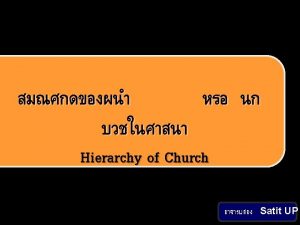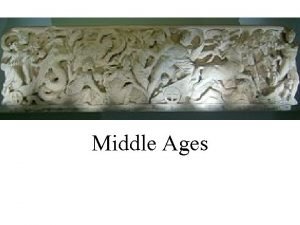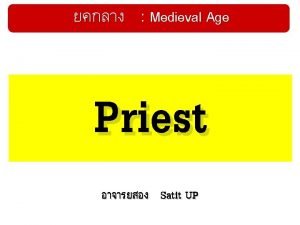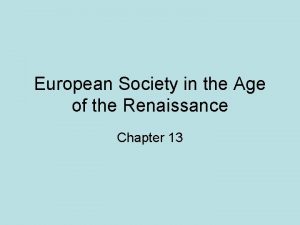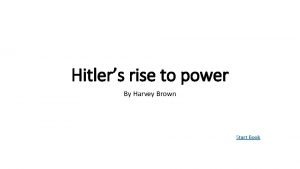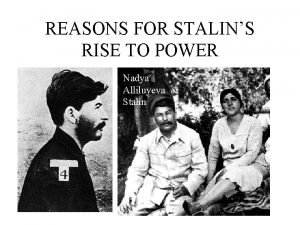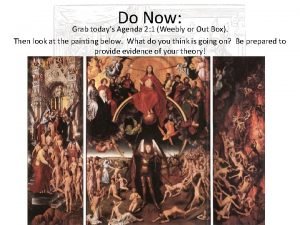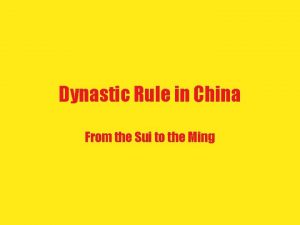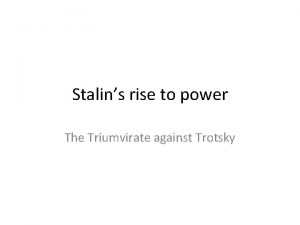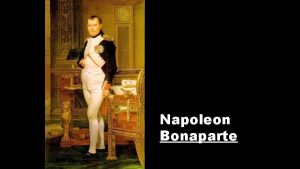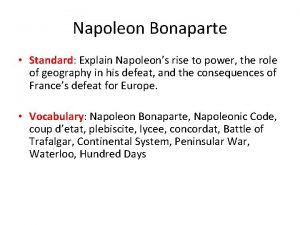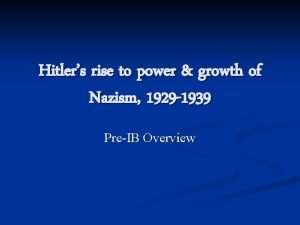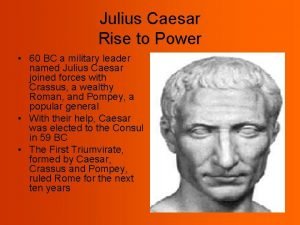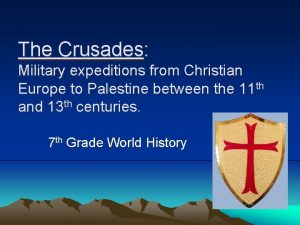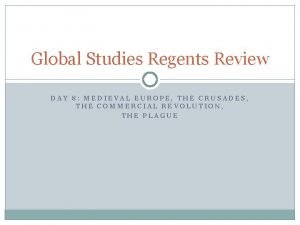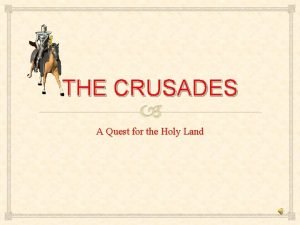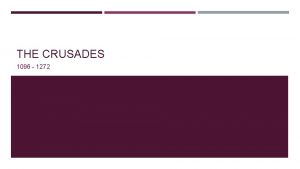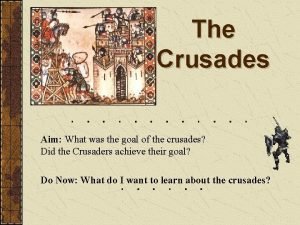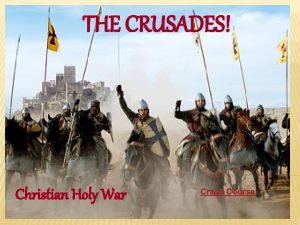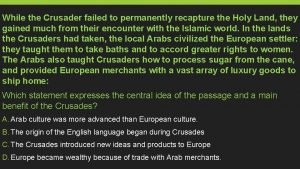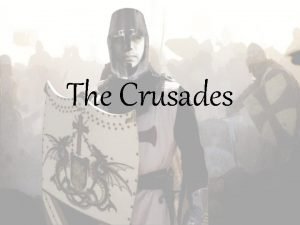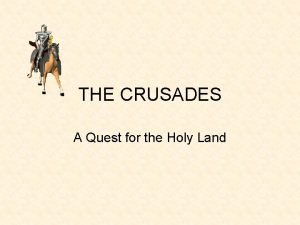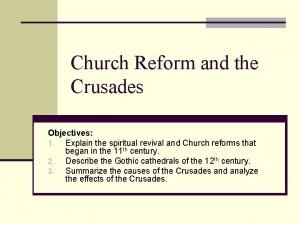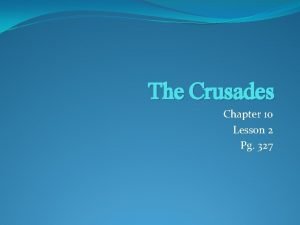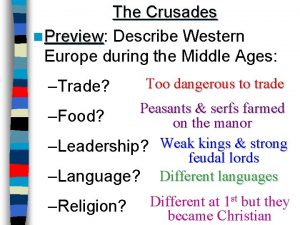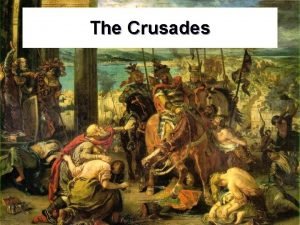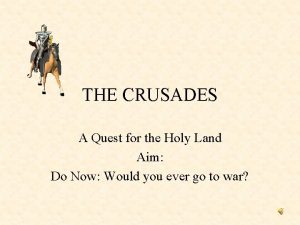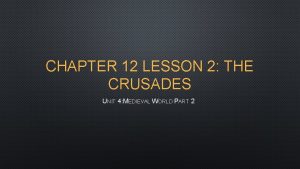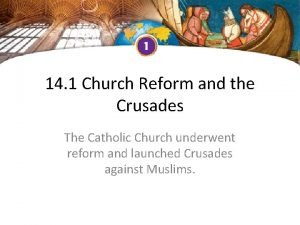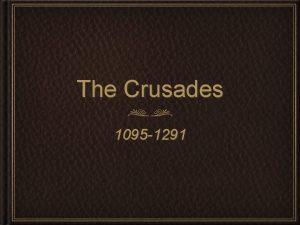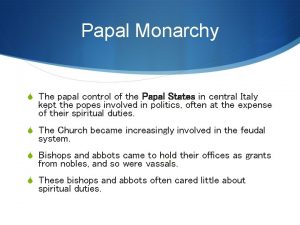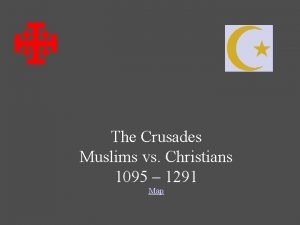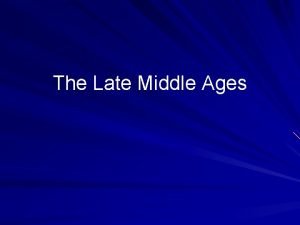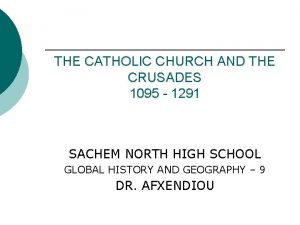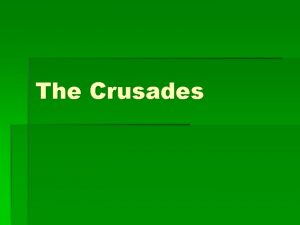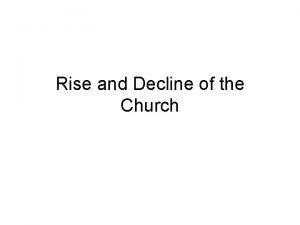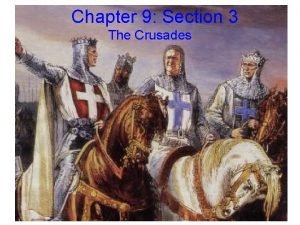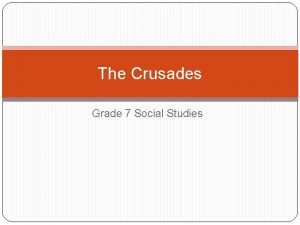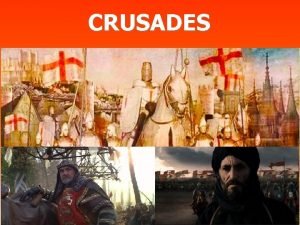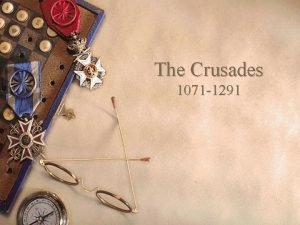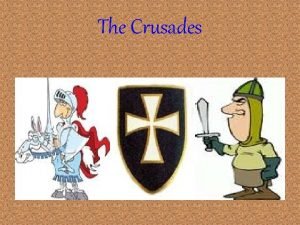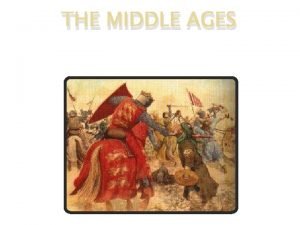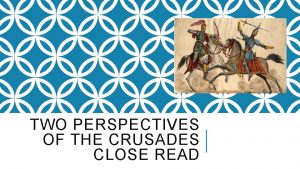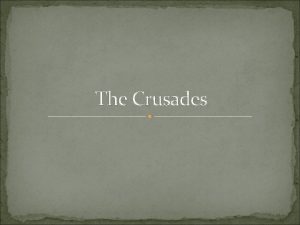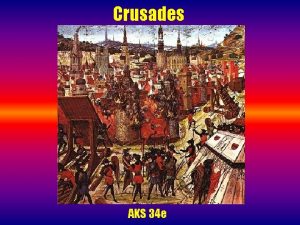The Crusades The Rise of Papal Power 1095
































































- Slides: 64

The Crusades & The Rise of Papal Power 1095 -1215


The Hanseatic League c. 1300

How did expansion of the economy facilitate growth of literacy between 1000 and 1300? A. B. C. D. E. The increase in trade required more merchants who could read contracts The increase in population and economic activity stimulated buying and selling of land Universities began to open all across Europe More people who afford to buy Bibles and other devotional literature All of the above

How did the growth of literacy facilitate the centralization of political power? A. B. C. D. By encouraging more peaceful methods for resolving disputes By facilitating economic activity, especially long distance trade By creating more efficient apparatuses for collecting and accounting for tax revenue All of the above


The German Emperor Henry III (r. 1046 -1056) advocated reform of the Church

Monarchies became increasingly powerful by 1300

Gregory VII Leader of Church Independence Pope from 1073 -1085


What’s the most accurate description of the Dictates of the Pope? A. B. C. A reasoned assertion of customary powers associated with the papacy An amalgam of political and religious powers claimed by a pope The first document outlining a clear division of authority between Church and state D. All of the above E. None of the above

Whaat was the tone of the Dictates? A. Desperate B. Condescending C. Arrogant D. Polite E. Conciliatory

Timeline for Background to the Rise of Papal Power & the Crusades ● ● ● 1040 s and 1050 s: Emperors encourage reform movement in the Church 1050: Christians successfully take Toledo; the reconquista gains momentum 1059: Papacy allies itself against emperors by signing Treaty of Melfi in 1059 1066: Papacy support Norman conquest of England 1075: Investiture conflict engulfs Italy and Germany




What topic did the pope first address in his Clermont speech? A. The failure of the clergy to remain celibate B. The Failure of the Truce of God C. The Success of the Treaty of Melfi D. The Depravity of the Holy Roman Emperors E. All of the above


Timeline for Crusades ● ● 1095: Pope delivers speech at Clermont 1096 -1099: First Crusade takes Jerusalem and established crusader states ● 1147 -1149: Second Crusade fails miserably ● 1189 -1193: Third Crusade ends in a draw ● ● 1198 -1203: Fourth Crusade capture Christian cities, Zara and Constantinople 1200 s and 1300 s: various crusades, many against Christians, with few making it to the Holy Land


Siege of Jerusalem, 1099


Crusader States during the twelfth century

What was the likely impact of Crusader states in the Holy Land? A. Increased cultural interaction between Muslims and Europeans B. Unification of the Muslim factions C. Increased trade for Europeans D. An outlet for Europeans seeking adventure E. Increase in the collective identify of Westerners

Templars and Hospitallers Christian Soldiers of the High Middle Ages

Krak de Chevalier – east of Tripoli

Crusader States during the twelfth century


Bernard of Clairvaux ● ● ● Cistercian leader during much of the movement’s first century Considered by many contemporaries the holiest man in Europe Preached the Second Crusade, 1147 -9

Portugal


The defeat of Christians at the Horns of Hattin sent shock waves across Europe 1187

Crusader States during the twelfth century


Leaders of the Third Crusade

Richard Lionheart & Truce with Saladin 1191

Innocent III 1161 -1216 r. 1198 -1216

Fourth Crusade’s Planned Course


The Venetian Mercantile Empire

Overview ● Background on Crusades ● The First Four Crusades ● Albigensian Crusade ● 13 th Century and Late Medieval Crusading ● Consequences of the Crusades

Background on Crusades ● Early wars against Muslims – The reconquista (1000 -1492) – The Norman conquest of Sicily (11 th century) ● ● In cooperation with papacy By 1060 s plans for crusades were under discussion among cardinals and leading bishops

Background ● ● ● The first crusade was conceived in the mid 11 th century and was meant to reverse the capture of Jerusalem and the Holy Land from recent Muslim invasions Crusades had the effect of rallying the most violent members of Europe around the defense of the Christian religion Whether consciously conceived as a way to pacify Europe or not, the exportation of violent members of European society to fight in foreign wars had the effect of pacifying European society

The First Crusade ● ● Conceived before the papacy of Gregory VII (1073 -85) but first preached by Urban II (1088 -99) at Clermont in 1095 Within a year of his sermon, two groups headed toward Constantinople – The People's Crusade, led by Peter the Hermit; they took the overland route – A slower and smaller contingent of well armed and equipped nobles some sailed to Constantinople while most also took the overland route

The First Crusade ● ● The People's Crusade arrived in Constantinople in late 1096 and received a cool reception – Poorly equipped – Little military experience – Undisciplined – Extraordinary religious faith The Byzantium Emperor provided transportation across the Bosporus to Asian Minor, where they were almost immediately massacred by Seljuk forces; the survivors returned to Constantinople and joined the knights in 1097

Summary of First Crusade ● ● ● The only Crusade to achieve its initial purpose: the recapture of Jerusalem and much of the Holy Land The territorial conquests were minor but they military victories demonstrated the ferocity of the western European warriors whose equipment and supplies were poorly suited to the hot, arid conditions of the Near East Increased contact between Europe and the rest of the Mediterranean

Second Crusade, 1147 -49 ● ● ● Inspired by Bernard of Clairvaux (1090 -1153) Led by Louis VII of France and Conrad III, Holy Roman Emperor A failure: “an abyss so deep that I must call him blessed who is not scandalized by it. ” Rivalry between the princes and also undermined by princes of the Holy Land Ended the Marriage of Louis VII and Eleanor of Aquitaine, who married Henry II of England Failed to take Damascus

Third Crusade, 1189 -1193 ● Reaction against the rising power of Saladin ● Led by – Emperor Frederick Barbarossa – Drowned on the way there King Phillip Augustus of France – Quarreled with Richard and went home Richard the Lion Hearted of England ● ● Richard enjoyed military and diplomatic success but failed to recapture Jerusalem; he was later taken hostage by the Holy Roman Emperor, Henry VI Ultimately this crusade was also a failure

Fourth Crusade, 1198 -1204 ● Initiated by Innocent III ● Led by territorial princes, notably Baldwin of Flanders ● Embarcation from Venice – ● Purpose hijacked by the Venetians: attacks on Zara and Constantinople Crusaders excommunicated by Innocent III twice but readmitted to the Church both times ● Huge influx of booty to the West ● Temporary re-unification of Christianity

Albigensian Crusade, 1209 -1229 ● The Cathars, 1150 -1250 – – – ● dual gods anti-clericalism rival church support in the Midi the perfecti The papal response – – – the Dominicans the Crusade Philip II “Augustus”

th 13 ● ● 1212: Children’s Crusade 1228: Crusade of Frederick II 1234 -41: Crusade of Thibault of Champagne and Richard of Cornwall Crusades of Louis IX (St. Louis) – – ● Century Crusades 1248 -54: Sixth Crusade 1270 -2: Seventh Crusade 1235 -90: The “Political” Crusades

Late Medieval Crusades ● ● 1291 -1336: Planned French Crusades 1365: Cypriot Crusade against Alexandria 1300 s & 1400 s: Crusades in the Baltic 1464: Crusade of Pope Pius II

Consequences of the Crusades ● ● Altered balance of power between Europe, Byzantium, and Islamic Caliphates The extension of papal power – – ● alliance with Normans and then the French against HRE popular politics Western Europe comes into more frequent contact with Byzantine and Muslim states – – increase of Arabic knowledge recovery of “lost” texts

The Crusades and the Papacy – – – Initiated by Urban II (c. 1100) Reinvigorated by Innocent III (c. 1200) Crusade as a means of eliminating heresy Political weapon against Hohenstaufen Emperors in mid-13 th century Strengthening of papal authority ● Moral leadership ● Military purpose Papal indulgences

Significance of the Crusades ● ● ● The next step in Constantine's vision: Militant Christianity Just War is sanctioned Western Europe goes on the offensive Attacks against Byzantines; ascendance of the West Conquests in mid-East Maritime benefits for Italian merchants

Summary ● ● Crusades elevated the papacy as the moral leader of western Europe Reduced violence against Christians by Christians The crusades initiated the practice of indulgences, which allowed those who could not make the trip to the holy land to sponsor a knight and thereby gain the spiritual advantages of crusading Brought control of the Mediterranean commerce into the hands of the Italians and especially the Venetians, who made enormous profits from trade with the Middle East

Summary ● ● The Crusades signified a change in the cultural and political position of Europe – Prior to the First Crusade (1095) the western Europeans had been viewed as disorganized barbarians – By the end of the Fourth Crusade (1205) the western Europeans not only gained control of shipping in the Mediterranean but they also demonstrated the ability to develop and adapt technology to their purposes The period of crusading coincided with a intellectual reawakening in Western Europe

How did increased wealth and population change European politics? How did the increased wealth change the culture of Europe? In what sense is competition ingrained in our political system?

What are the advantages of competition? In what sense is competition ingrained in our political system?

In the Dictates of the Pope, Gregory VII did which of the following? A. B. C. D. Established the primacy of the papacy in matters spiritual and temporal Claimed that the Church had no business is temporal or political matters Established a set of guidelines for reforming the behavior of monks Called for the first crusade


Make an educated guess? How did increased population and wealth influence political leaders? Where was this trend most noticeable? In what sense was the papacy a political power?

What was the point of the Dictates of the Pope? How would you characterize the tone of the document? What does the document suggest about the institution of the papacy?

Make an educated guess How did the Crusades reflect changes in the aspirations of the papacy? How did the call for the First Crusade at Clermont reflect the increasing confidence and influence of the papacy?
 Hierarchy of catholic church
Hierarchy of catholic church Papal state
Papal state Benedictine rule
Benedictine rule The claim of papal supremacy held that
The claim of papal supremacy held that Catholic ranks
Catholic ranks Papal state
Papal state Tricky dick: the rise and fall and rise of richard m. nixon
Tricky dick: the rise and fall and rise of richard m. nixon Rise again and again until lambs
Rise again and again until lambs A union b example
A union b example Rise and rise again
Rise and rise again Ac power formula
Ac power formula Harvey rise to power
Harvey rise to power Nadya alliluyeva
Nadya alliluyeva Rise of power
Rise of power How did the sui dynasty rise to power
How did the sui dynasty rise to power Stalins rise to power
Stalins rise to power Napoleon bonaparte timeline
Napoleon bonaparte timeline Sequencing napoleon's rise to power
Sequencing napoleon's rise to power Explain the rise of napoleon
Explain the rise of napoleon Julius caesar rise to power
Julius caesar rise to power Lion prince of mali
Lion prince of mali Hitler rise to power
Hitler rise to power How did hitler rise to power
How did hitler rise to power Caesar's rise to power
Caesar's rise to power Crusades through arab eyes
Crusades through arab eyes The crusades were military expeditions undertaken by
The crusades were military expeditions undertaken by Middle ages regents questions
Middle ages regents questions Crusades recruitment poster ideas
Crusades recruitment poster ideas Were the crusades successful
Were the crusades successful What were the goals of the crusades
What were the goals of the crusades Crash course the crusades
Crash course the crusades The crusades a jigsaw activity answer key
The crusades a jigsaw activity answer key The crusades webquest
The crusades webquest Positives of the crusades
Positives of the crusades Crusades
Crusades Crusades recruitment poster
Crusades recruitment poster The crusades were military expeditions undertaken by
The crusades were military expeditions undertaken by Church reform and the crusades
Church reform and the crusades Lesson 2 the crusades
Lesson 2 the crusades How did the crusades change europe
How did the crusades change europe Crusades used in a sentence
Crusades used in a sentence Crusades recruitment poster
Crusades recruitment poster Chapter 12 lesson 3 culture of the middle ages
Chapter 12 lesson 3 culture of the middle ages Chapter 14 section 1 church reform and the crusades
Chapter 14 section 1 church reform and the crusades Power angle curve in power system stability
Power angle curve in power system stability Solar power satellites and microwave power transmission
Solar power satellites and microwave power transmission Dispersive power of grating is inversely proportional to
Dispersive power of grating is inversely proportional to Power bi power point
Power bi power point Power of a power property
Power of a power property Power absorbed or delivered
Power absorbed or delivered Actual power
Actual power General power rule vs power rule
General power rule vs power rule Flex28024a
Flex28024a Nguyên nhân của sự mỏi cơ sinh 8
Nguyên nhân của sự mỏi cơ sinh 8 Vẽ hình chiếu đứng bằng cạnh của vật thể
Vẽ hình chiếu đứng bằng cạnh của vật thể Phản ứng thế ankan
Phản ứng thế ankan Các môn thể thao bắt đầu bằng tiếng nhảy
Các môn thể thao bắt đầu bằng tiếng nhảy Chó sói
Chó sói Thiếu nhi thế giới liên hoan
Thiếu nhi thế giới liên hoan Sự nuôi và dạy con của hươu
Sự nuôi và dạy con của hươu điện thế nghỉ
điện thế nghỉ Một số thể thơ truyền thống
Một số thể thơ truyền thống Trời xanh đây là của chúng ta thể thơ
Trời xanh đây là của chúng ta thể thơ Lp html
Lp html Các số nguyên tố
Các số nguyên tố
